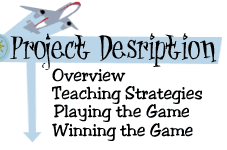|
Gather a few materials for the class so that the students can break up into small groups to begin the process of matching locations up with descriptions.
Suggested Materials:
- Large United States map showing time zones and latitudes
- Set of encyclopedias for individual state maps and maps of other countries
- AAA road maps
- Rand McNally Road Atlas
- Almanac
Select one of our current Classic or Instant Games. Print the GeoGame game file from the web and duplicate enough copies of the city/state locations to give one to each child in your class. Print out the descriptions "clues", divide your class up into 4 or 5 groups and give each group an equal number of the descriptions.
You might want to set aside two or three 20-30 minute "Research Periods" for the groups to try to match up their descriptions with the city/state locations. Or, you may want to set up a reference corner in the library or your classroom where students can go work on the project during their free time.
If you have problems finding a reference for the time zones, contact your long distance phone company. Most have maps showing the world time zones related to GMT. Check out the references on our web site.
When your students have done the best job they can on the match ups, print the number of the clue next to the City on the list. Then, return to that game on the Web and submit your answers in the form at the game page.
Other Strategies:
One teacher set up a bulletin board with a large map. Students located the cities and marked them with map tacks. Then they matched the descriptions with the cities on the map.
Another teacher chose the following strategy. Copy the list of cities so that there is one list for each clue. The clues are separated so there is one clue viewed at at a time. These two items are mounted on construction paper (aesthetic component only) and laminated.
Students use an overheard marker to cross off eliminated possibilities and narrow down the answer.
Ambitious children list strategies on the back of the card:
- using the time zone to eliminate countries and/or states,
- next using latitude to eliminate more countries and/or states,
- then using tourist attractions if commonly known and if not looking up state in encyclopedia to see if the attractions are listed (some encyclopedias have this as a listing in the beginning of information for each state),
- and finally using a map or atlas which also lists populations for different cities (especially if it is narrowed down to cities relatively close to one another).
Once they have an answer they turn it in. When all the clues for a given game are turned in, they are put in order to see if there are any "repeats". If there are, a committee of three students goes over these to come to agreement about correct responses. Then the cards are wiped with lightly moistened tissue for use by others.
It made a tremendous difference to my students to have things broken down a bit. It is also more fun to use overhead markers and colorful paper than it is to use notebook paper and pencils. (Even these sophisticated, "young adults" enjoy the little things.)
(Teachers, if you have a unique way to work on GeoGame, please Let us know. We may include it here for other teachers to use.)
| 


